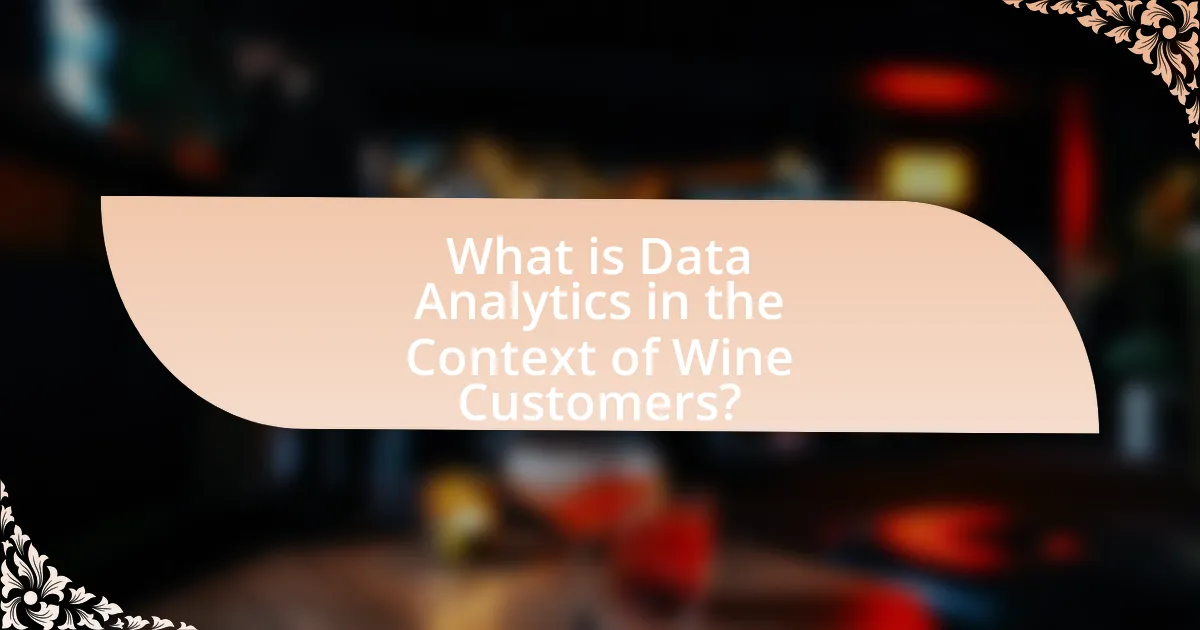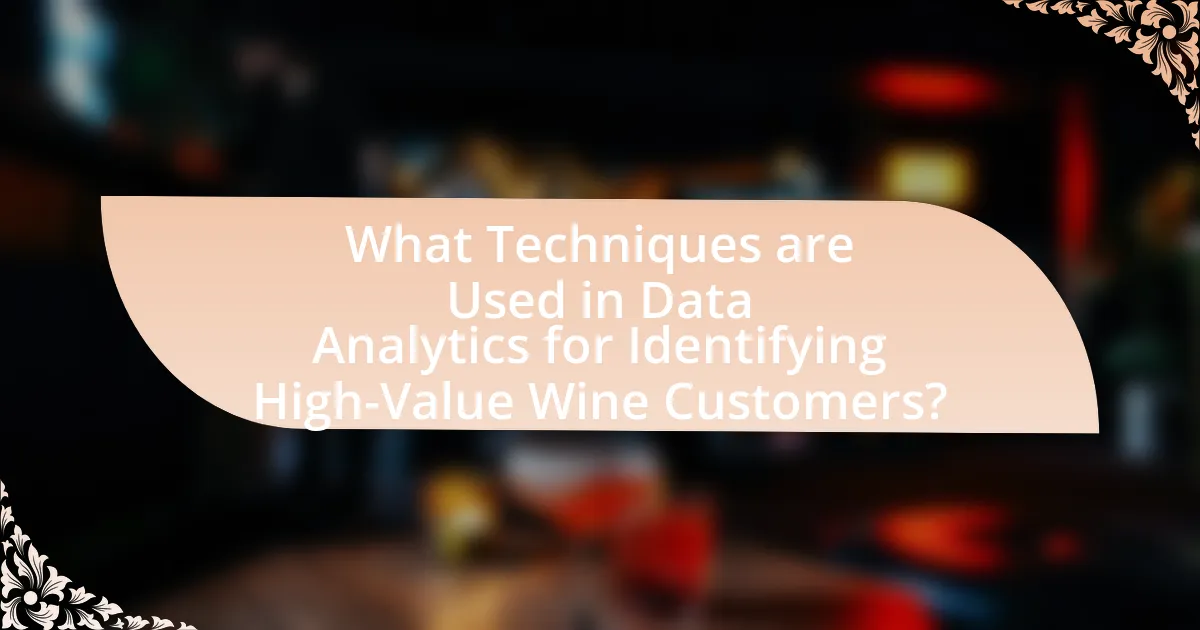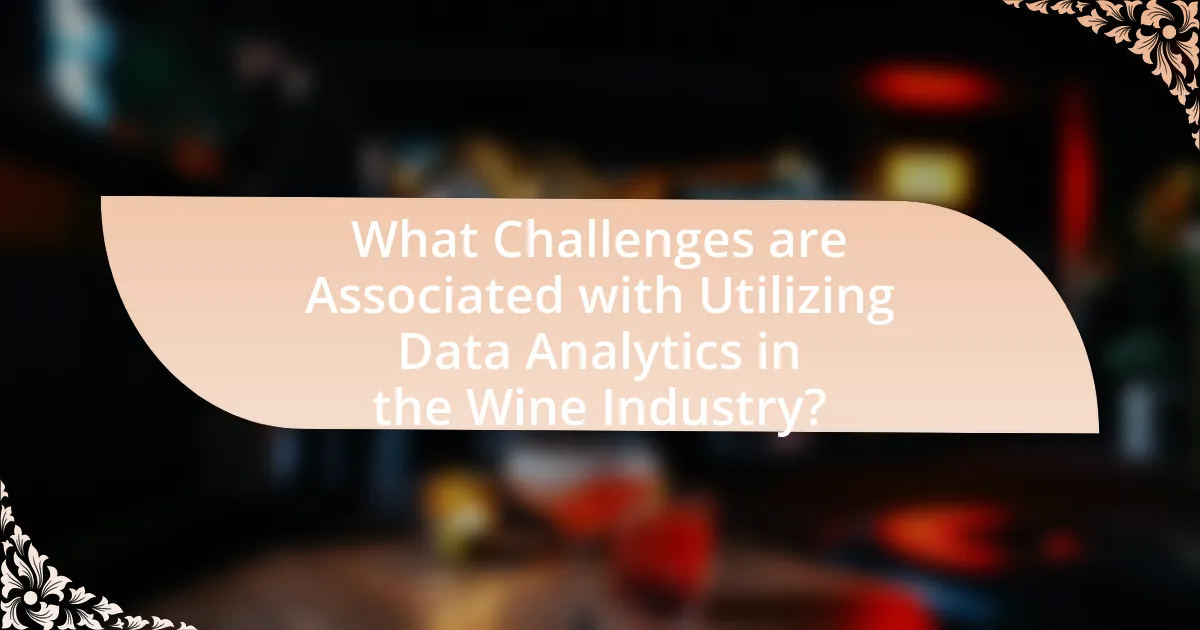The article focuses on utilizing data analytics to identify high-value wine customers, emphasizing the systematic analysis of consumer behavior, preferences, and purchasing patterns within the wine market. It outlines how data analytics can enhance marketing strategies, optimize pricing, and improve customer retention by identifying key customer segments. The article discusses the types of data collected, the processing and analysis techniques employed, and the importance of understanding high-value customers for maximizing profitability. Additionally, it addresses challenges such as data quality issues and privacy concerns, while recommending best practices and tools for effective data analysis in the wine industry.

What is Data Analytics in the Context of Wine Customers?
Data analytics in the context of wine customers refers to the systematic analysis of data related to consumer behavior, preferences, and purchasing patterns within the wine market. This process enables wine businesses to identify high-value customers by examining factors such as purchase frequency, average spend, and product preferences. For instance, a study by McKinsey & Company highlights that data-driven insights can increase customer retention rates by up to 30%, demonstrating the effectiveness of analytics in targeting and retaining valuable wine customers.
How does data analytics apply to the wine industry?
Data analytics applies to the wine industry by enabling producers and retailers to understand consumer preferences, optimize pricing strategies, and enhance marketing efforts. For instance, wineries can analyze sales data to identify trends in customer purchasing behavior, allowing them to tailor their offerings to meet demand. A study by the University of California, Davis, found that data-driven decision-making can increase sales by up to 20% in the wine sector. Additionally, analytics can help in segmenting customers based on their buying patterns, which aids in targeting high-value customers more effectively. This targeted approach not only improves customer satisfaction but also maximizes profitability for wine businesses.
What types of data are collected from wine customers?
Wine customers’ data typically includes demographic information, purchase history, preferences, and feedback. Demographic information encompasses age, gender, income level, and location, which helps in segmenting the customer base. Purchase history records the types of wines bought, frequency of purchases, and average spending, providing insights into customer behavior. Preferences detail specific wine varietals, regions, and price points favored by customers, aiding in targeted marketing efforts. Feedback, often collected through surveys or reviews, offers qualitative insights into customer satisfaction and areas for improvement. Collectively, this data enables wineries and retailers to tailor their offerings and marketing strategies effectively.
How is this data processed and analyzed?
Data is processed and analyzed through a combination of data collection, cleaning, and statistical modeling techniques. Initially, data is gathered from various sources such as customer transactions, surveys, and online interactions. This raw data is then cleaned to remove inaccuracies and inconsistencies, ensuring that the dataset is reliable for analysis.
Subsequently, statistical models and algorithms are applied to identify patterns and trends that reveal customer behaviors and preferences. For instance, clustering algorithms can segment customers based on purchasing habits, while regression analysis can predict future buying behaviors. These analytical methods enable businesses to pinpoint high-value wine customers effectively, enhancing targeted marketing strategies and improving customer retention.
The validity of this approach is supported by studies showing that data-driven decision-making can increase sales by up to 20%, as reported by McKinsey & Company in their research on analytics in retail.
Why is identifying high-value wine customers important?
Identifying high-value wine customers is important because it enables businesses to optimize marketing strategies and enhance customer retention. By focusing on customers who contribute significantly to revenue, companies can tailor their offerings and communications to meet the specific preferences of these individuals. Research indicates that 20% of customers often account for 80% of sales, a principle known as the Pareto Principle. This insight underscores the necessity of identifying and nurturing high-value customers to maximize profitability and ensure sustainable growth in the competitive wine market.
What characteristics define high-value wine customers?
High-value wine customers are typically characterized by their purchasing frequency, average spend per transaction, and brand loyalty. These customers often buy premium wines regularly, demonstrating a willingness to invest in higher-priced products, which can be quantified through sales data analysis. Research indicates that high-value customers contribute significantly to revenue, with studies showing that 20% of customers can account for 80% of sales in the wine industry. Additionally, they tend to engage with brands through multiple channels, including online platforms and in-person events, further solidifying their loyalty and enhancing their lifetime value.
How does understanding these customers impact business strategies?
Understanding high-value wine customers significantly impacts business strategies by enabling targeted marketing, personalized customer experiences, and optimized product offerings. When businesses analyze customer data, they can identify purchasing patterns, preferences, and demographics, allowing for tailored marketing campaigns that resonate with specific segments. For instance, a study by McKinsey & Company found that companies using data analytics to understand customer behavior can increase their marketing ROI by 15-20%. This targeted approach not only enhances customer satisfaction but also drives sales growth, as businesses can align their product offerings with the preferences of their most valuable customers.

What Techniques are Used in Data Analytics for Identifying High-Value Wine Customers?
Data analytics techniques for identifying high-value wine customers include customer segmentation, predictive modeling, and lifetime value analysis. Customer segmentation utilizes demographic and behavioral data to categorize customers into distinct groups, allowing businesses to tailor marketing strategies effectively. Predictive modeling employs statistical algorithms and machine learning to forecast future purchasing behaviors based on historical data, helping to identify customers likely to make high-value purchases. Lifetime value analysis calculates the total revenue a customer is expected to generate over their relationship with the business, enabling companies to focus on retaining their most profitable customers. These techniques are supported by data-driven insights that enhance targeting and personalization in marketing efforts.
How do predictive analytics contribute to customer identification?
Predictive analytics significantly enhances customer identification by analyzing historical data to forecast future behaviors and preferences. This analytical approach utilizes algorithms and statistical models to identify patterns in customer data, such as purchasing history and demographic information, which helps businesses segment their customer base effectively. For instance, a study by McKinsey & Company found that companies using predictive analytics can improve their marketing effectiveness by up to 15-20%, allowing them to target high-value customers more accurately. By leveraging these insights, businesses can tailor their offerings and marketing strategies to meet the specific needs of identified customer segments, ultimately driving sales and customer loyalty.
What algorithms are commonly used in predictive analytics?
Common algorithms used in predictive analytics include linear regression, decision trees, random forests, support vector machines, and neural networks. Linear regression is frequently employed for predicting continuous outcomes based on linear relationships between variables. Decision trees provide a visual representation of decision-making processes and are useful for classification tasks. Random forests, an ensemble method, enhance prediction accuracy by combining multiple decision trees. Support vector machines are effective in high-dimensional spaces for classification problems. Neural networks, particularly deep learning models, excel in capturing complex patterns in large datasets. These algorithms are widely adopted due to their proven effectiveness in various predictive analytics applications, including customer segmentation and behavior forecasting.
How can predictive analytics improve customer targeting?
Predictive analytics can improve customer targeting by analyzing historical data to identify patterns and trends that indicate customer preferences and behaviors. This data-driven approach allows businesses to segment their customer base more effectively, tailoring marketing strategies to specific groups. For instance, a study by McKinsey & Company found that companies using predictive analytics for customer segmentation can increase their marketing ROI by 15-20%. By leveraging insights from predictive models, businesses can enhance their targeting accuracy, leading to higher engagement and conversion rates among high-value wine customers.
What role does customer segmentation play in data analytics?
Customer segmentation plays a crucial role in data analytics by enabling businesses to categorize their customer base into distinct groups based on shared characteristics. This categorization allows companies to tailor marketing strategies, optimize product offerings, and enhance customer experiences, ultimately leading to increased sales and customer loyalty. For instance, a study by McKinsey & Company found that companies that excel in customer segmentation can achieve up to 10% higher revenue growth compared to their competitors. By leveraging data analytics for segmentation, businesses can identify high-value wine customers more effectively, ensuring that marketing efforts are directed towards the most profitable segments.
What methods are used for segmenting wine customers?
Methods used for segmenting wine customers include demographic segmentation, psychographic segmentation, behavioral segmentation, and geographic segmentation. Demographic segmentation categorizes customers based on age, gender, income, and education level, allowing businesses to tailor marketing strategies effectively. Psychographic segmentation focuses on customers’ lifestyles, values, and interests, providing deeper insights into purchasing motivations. Behavioral segmentation analyzes customer interactions, such as purchase frequency and brand loyalty, to identify patterns and preferences. Geographic segmentation divides customers based on location, which can influence wine preferences and buying habits. These methods enable wine businesses to target specific customer groups more effectively, enhancing marketing efficiency and customer satisfaction.
How does segmentation enhance marketing efforts?
Segmentation enhances marketing efforts by allowing businesses to tailor their strategies to specific customer groups, thereby increasing engagement and conversion rates. By dividing the market into distinct segments based on characteristics such as demographics, purchasing behavior, and preferences, companies can create targeted campaigns that resonate more effectively with each group. For instance, research from the Journal of Marketing found that targeted marketing campaigns can lead to a 20% increase in sales compared to non-targeted efforts. This precision in targeting not only improves customer satisfaction but also optimizes resource allocation, ensuring that marketing budgets are spent on the most promising segments.

What Challenges are Associated with Utilizing Data Analytics in the Wine Industry?
Utilizing data analytics in the wine industry presents several challenges, including data quality issues, integration difficulties, and the need for specialized expertise. Data quality issues arise from inconsistent or incomplete data, which can lead to inaccurate insights. Integration difficulties occur when combining data from various sources, such as sales, customer feedback, and production metrics, making it hard to create a unified view. Additionally, the wine industry often lacks personnel with the necessary data analytics skills, hindering effective analysis and decision-making. These challenges can impede the ability to identify high-value wine customers accurately.
What data privacy concerns arise when analyzing customer data?
Data privacy concerns that arise when analyzing customer data include unauthorized access, data breaches, and misuse of personal information. Unauthorized access can occur when sensitive customer data is not adequately protected, leading to potential exploitation by malicious actors. Data breaches have been reported frequently, with the Identity Theft Resource Center noting over 1,100 data breaches in the U.S. in 2020 alone, exposing millions of records. Misuse of personal information can happen when companies utilize customer data for purposes beyond the original intent, violating privacy regulations such as the General Data Protection Regulation (GDPR), which mandates explicit consent for data usage. These concerns highlight the importance of implementing robust data protection measures and adhering to legal frameworks to safeguard customer privacy.
How can wineries ensure compliance with data protection regulations?
Wineries can ensure compliance with data protection regulations by implementing robust data governance policies and practices. This includes conducting regular audits to assess data handling processes, ensuring that customer consent is obtained for data collection, and providing transparent privacy notices that explain how customer data will be used. Additionally, wineries should train staff on data protection principles and invest in secure data storage solutions to protect sensitive information. According to the General Data Protection Regulation (GDPR), organizations must demonstrate accountability and transparency in their data processing activities, which reinforces the need for these compliance measures.
What best practices can be implemented to safeguard customer information?
To safeguard customer information, organizations should implement strong encryption methods for data storage and transmission. Encryption protects sensitive data by converting it into a format that can only be read by authorized users, thereby reducing the risk of unauthorized access. According to a report by the Ponemon Institute, organizations that use encryption experience 50% fewer data breaches compared to those that do not. Additionally, regular security audits and employee training on data protection practices are essential to ensure compliance with regulations such as GDPR and CCPA, which mandate strict data handling protocols. These practices collectively enhance the security framework surrounding customer information.
What limitations exist in data analytics for wine customer identification?
Data analytics for wine customer identification faces several limitations, including data quality issues, privacy concerns, and the complexity of consumer behavior. Data quality issues arise from incomplete or inaccurate customer information, which can lead to misleading insights. Privacy concerns limit the ability to collect comprehensive data due to regulations like GDPR, restricting access to valuable customer information. Additionally, the complexity of consumer behavior makes it challenging to accurately segment and predict customer preferences, as wine purchasing decisions are influenced by various factors such as cultural trends, personal tastes, and social influences. These limitations hinder the effectiveness of data analytics in accurately identifying high-value wine customers.
How can data quality issues affect analysis outcomes?
Data quality issues can significantly distort analysis outcomes by leading to incorrect conclusions and misguided business decisions. For instance, inaccurate or incomplete data can result in flawed customer segmentation, which may misidentify high-value wine customers. A study by Redman (2018) highlights that poor data quality can lead to a 20% increase in operational costs due to inefficiencies and errors in decision-making processes. Furthermore, if the data used for analysis contains duplicates or inconsistencies, it can skew the results, causing businesses to overlook potential high-value customers or misallocate marketing resources. Thus, ensuring high data quality is essential for accurate analysis and effective customer identification in the wine industry.
What strategies can mitigate these limitations?
To mitigate the limitations of utilizing data analytics in identifying high-value wine customers, businesses can implement targeted segmentation strategies. Targeted segmentation allows companies to categorize customers based on specific behaviors, preferences, and purchasing patterns, enhancing the accuracy of data analysis. For instance, using advanced machine learning algorithms can improve predictive analytics, enabling businesses to identify potential high-value customers more effectively. Research by McKinsey & Company indicates that companies employing data-driven segmentation strategies can increase their marketing ROI by 15-20%. Additionally, integrating customer feedback mechanisms can provide qualitative insights that complement quantitative data, further refining customer profiles and enhancing targeting efforts.
What are the best practices for leveraging data analytics to identify high-value wine customers?
The best practices for leveraging data analytics to identify high-value wine customers include segmenting customer data, analyzing purchasing behavior, and utilizing predictive analytics. Segmenting customer data allows businesses to categorize customers based on demographics, preferences, and buying patterns, which helps in targeting high-value segments effectively. Analyzing purchasing behavior reveals insights into frequency, average spend, and product preferences, enabling businesses to tailor marketing strategies. Utilizing predictive analytics can forecast future buying behaviors based on historical data, allowing for proactive engagement with potential high-value customers. These practices are supported by studies showing that targeted marketing can increase customer retention rates by up to 30%, demonstrating the effectiveness of data-driven strategies in identifying and nurturing high-value wine customers.
How can wineries effectively implement data analytics strategies?
Wineries can effectively implement data analytics strategies by integrating advanced analytics tools to analyze customer data, sales trends, and market preferences. By utilizing customer relationship management (CRM) systems, wineries can collect and analyze data on purchasing behaviors, demographics, and preferences, allowing them to identify high-value customers. For instance, a study by McKinsey & Company found that companies leveraging data analytics can increase their profitability by 5-6% through better customer targeting and personalized marketing efforts. Additionally, employing predictive analytics can help wineries forecast demand and optimize inventory management, ensuring they meet customer needs efficiently.
What tools and technologies are recommended for data analysis in the wine industry?
Recommended tools and technologies for data analysis in the wine industry include Python, R, Tableau, and SQL. Python and R are widely used for statistical analysis and data manipulation, allowing wine industry professionals to analyze large datasets effectively. Tableau provides powerful data visualization capabilities, enabling users to create interactive dashboards that highlight trends and insights in wine sales and customer preferences. SQL is essential for managing and querying relational databases, facilitating the extraction of relevant data for analysis. These tools collectively enhance the ability to identify high-value wine customers through data-driven insights.